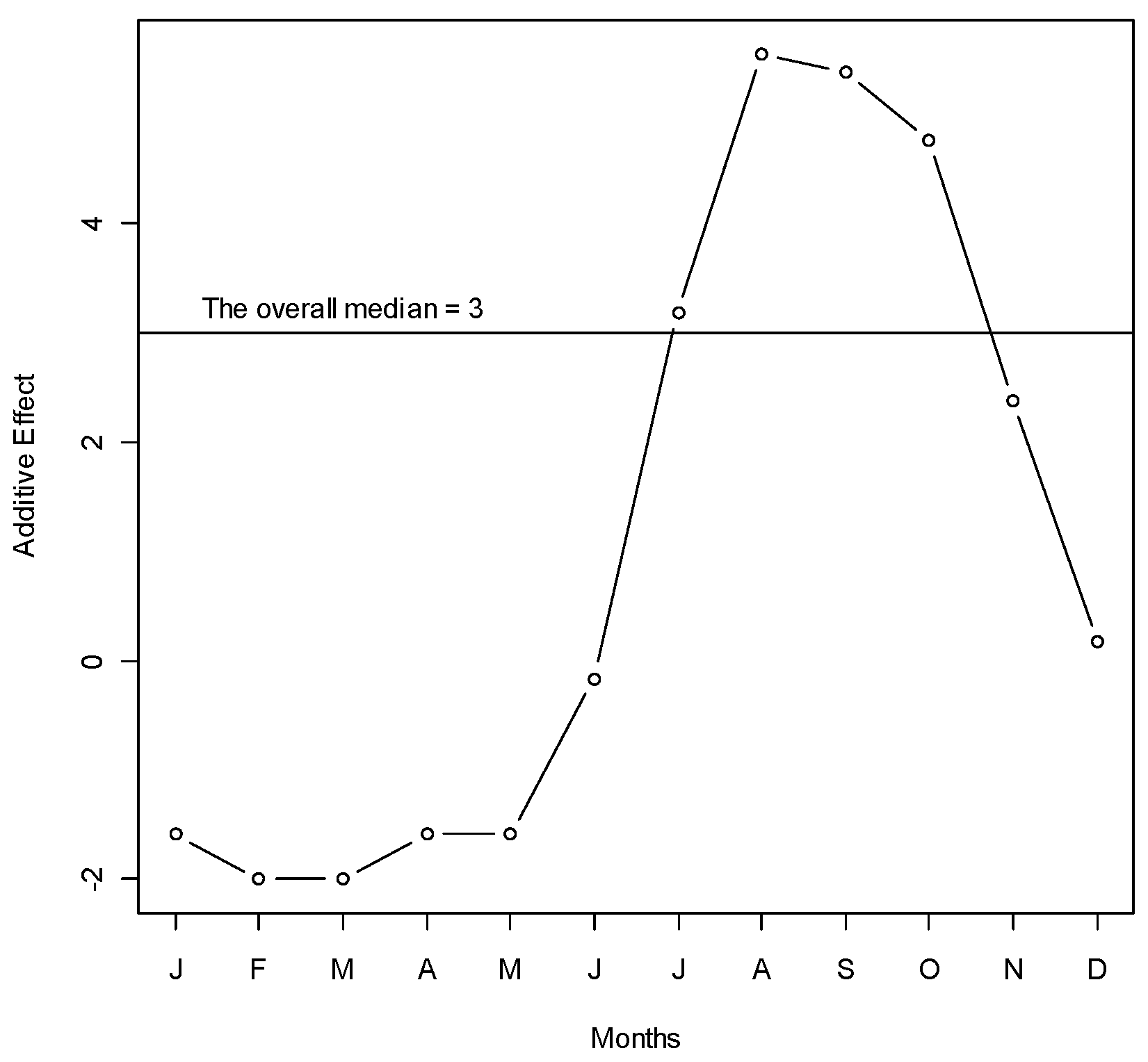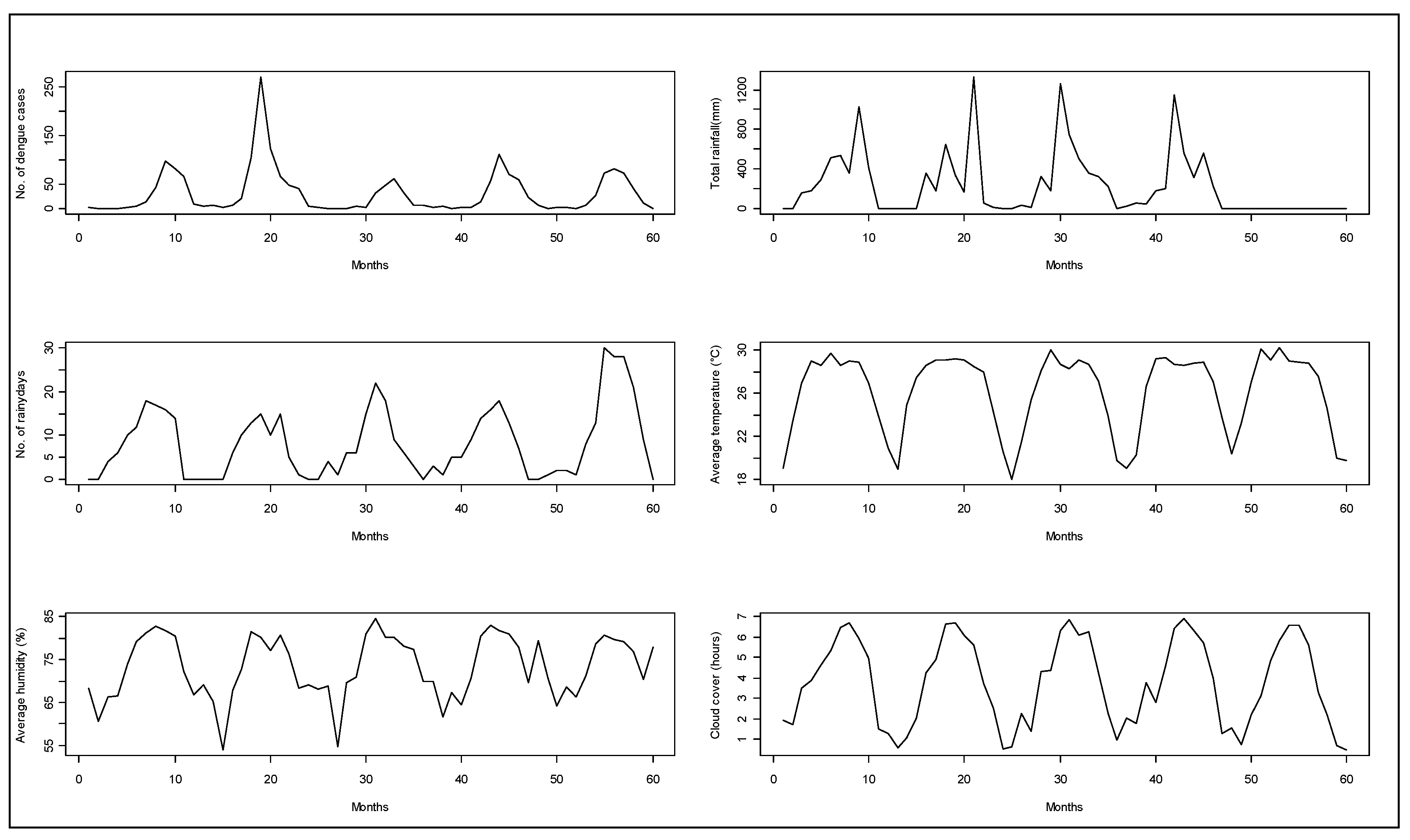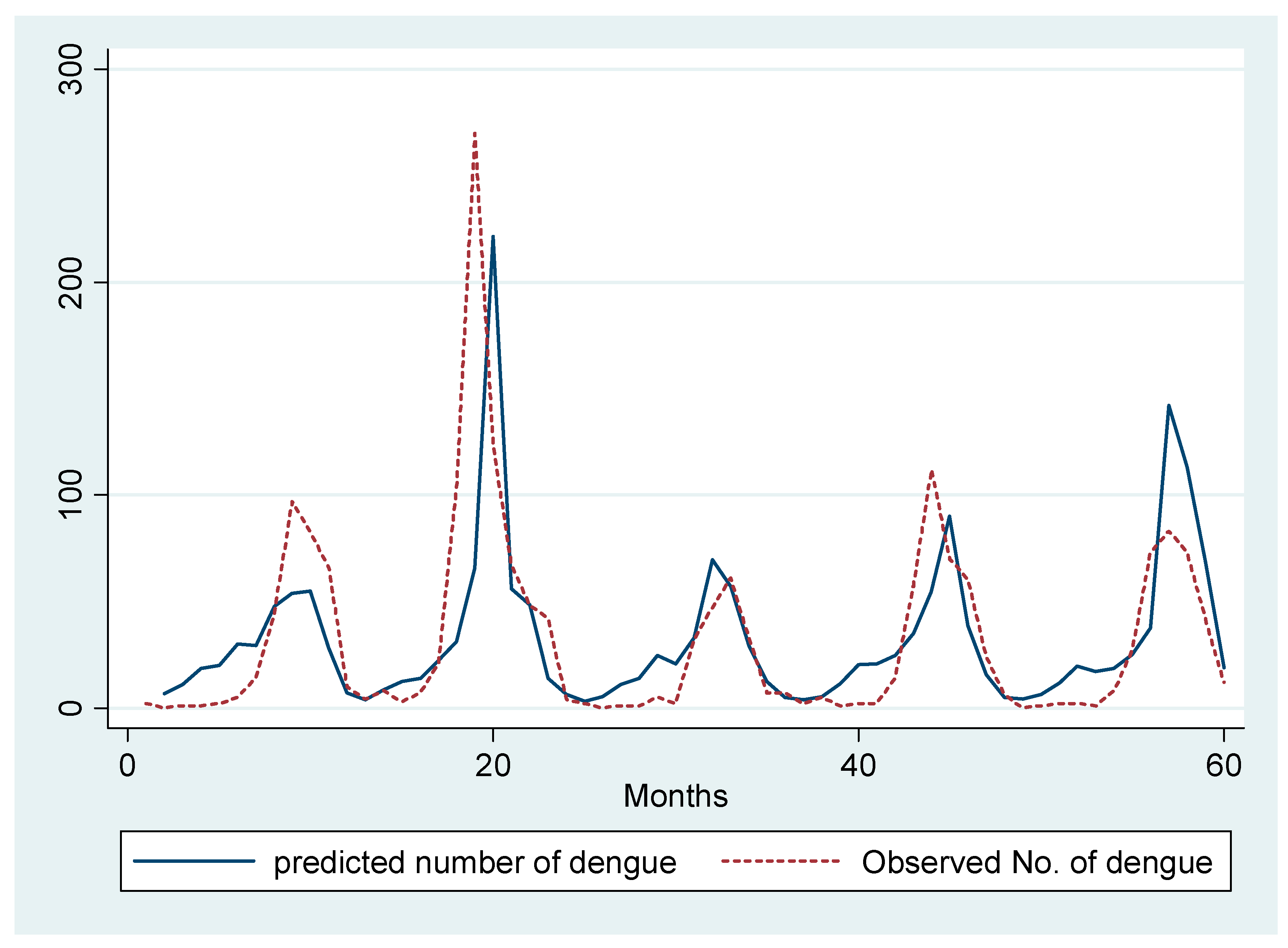An Association between Rainy Days with Clinical Dengue Fever in Dhaka, Bangladesh: Findings from a Hospital Based Study
Abstract
1. Introduction
2. Methods
2.1. Data Collection
2.2. Data Management and Analysis
2.3. Ethics
3. Results
4. Discussion
5. Conclusions
Supplementary Materials
Author Contributions
Funding
Acknowledgments
Conflicts of Interest
References
- Gubler, D.J. Dengue and dengue hemorrhagic fever. Clin. Microbiol Rev. 1998, 11, 480–496. [Google Scholar] [CrossRef]
- WHO. Dengue: Guidelines for Diagnosis, Treatment, Prevention and Control—New Edition; WHO: Geneva, Switzerland, 2009. [Google Scholar]
- WHO. Dengue and Severe Dengue. Available online: http://www.who.int/mediacentre/factsheets/fs117/en/index.html (accessed on 30 November 2020).
- Halstead, S.B. Dengue haemorrhagic fever-a public health problem and a field for research. Bull. World Health Organ. 1980, 58, 1–21. [Google Scholar]
- Halstead, S.B. Pathogenesis of dengue: Challenges to molecular biology. Science 1988, 239, 476–481. [Google Scholar] [CrossRef]
- Halstead, S.B.; Rojanasuphot, S.; Sangkawibha, N. Original antigenic sin in dengue. Am. J. Trop. Med. Hyg. 1983, 32, 154–156. [Google Scholar] [CrossRef] [PubMed]
- Beatty, M.E.; Letson, G.W.; Margolis, H.S. Estimating the global burden of dengue. In Proceedings of the 2nd International Conference on Dengue and Dengue Haemorrhagic Fever, Phuket, Thailand, 17–19 October 2008. [Google Scholar]
- Bhatt, S.; Gething, P.W.; Brady, O.J.; Messina, J.P.; Farlow, A.W.; Moyes, C.L.; Drake, J.M.; Brownstein, J.S.; Hoen, A.G.; Sankoh, O.; et al. The global distribution and burden of dengue. Nature 2013, 496, 504–507. [Google Scholar] [CrossRef] [PubMed]
- WHO. Situation Update of Dengue in the SEA Region. 2010. Available online: http://www.searo.who.int/LinkFiles/Dengue_Dengue_update_SEA_2010.pdf (accessed on 8 June 2012).
- Aziz, M.A.; Graham, R.R.; Greg, M.B. ‘Dacca fever’-An outbreak of dengue. Pak. J. Med. Res. 1967, 6, 83–92. [Google Scholar]
- Hossain, M.A.; Khatun, M.; Arjumand, F.; Nisaluk, A.; Breiman, R.F. Serologic evidence of dengue infection before onset of epidemic, Bangladesh. Emerg. Infect. Dis. 2003, 9, 1411–1414. [Google Scholar] [CrossRef] [PubMed]
- Sharmin, S.; Viennet, E.; Glass, K.; Harley, D. The emergence of dengue in Bangladesh: Epidemiology, challenges and future disease risk. Trans. R. Soc. Trop. Med. Hyg. 2015, 109, 619–627. [Google Scholar] [CrossRef]
- Amin, M.; Hussain, A.; Nahar, K.; Choudhury, I.; Murshed, M.; Choudhury, S. Sero-diagnosis of Dengue infections in four metropolitan cities of bangladesh. Dengue Bull. 2000, 24, 29–33. [Google Scholar]
- Yunus, E.B.; Mannan Bangali, A.; Ataul Huq Mahmood, M.; Mushfiqur Rahman, M.; Chowdhury, A.R.; Talukder, K.R. Dengue outbreak 2000 in Bangladesh: From speculation to reality and exercises. Dengue Bull. 2001, 25, 15–20. [Google Scholar]
- Rahman, M.; Rahman, K.; Siddque, A.K.; Shoma, S.; Kamal, A.H.M.; Ali, K.S.; Nisaluk, A.; Breiman, R.F. First outbreak of dengue hemorrhagic fever, Bangladesh. Emerg. Infect. Dis. 2002, 8, 738–740. [Google Scholar] [CrossRef] [PubMed]
- Aziz, M.M.; Hasan, K.N.; Hasanat, M.A.; Siddiqui, M.A.; Salimullah, M.; Chowdhury, A.K.; Ahmed, M.; Alam, M.N.; Hassan, M.S. Predominance of DEN-3 genotype during the recent dengue outbreak in Bangladesh. Southeast Asian J. Trop. Med. Public Health 2002, 33, 42–48. [Google Scholar] [PubMed]
- Podder, G.; Breiman, R.F.; Azim, T.; Thu, H.M.; Velathanthiri, N.; Mai, L.E.Q.; Lowry, K.Y.M.; Aaskov, J.G. Origin of dengue type 3 viruses associated with the dengue outbreak in Dhaka, Bangladesh, in 2000 and 2001. Am. J. Trop. Med. Hyg. 2006, 74, 263. [Google Scholar] [CrossRef] [PubMed]
- Choudhury, M.A.H.Z.; Banu, S.; Islam, M.A. Forecasting dengue incidence in Dhaka, Bangladesh: A time series analysis. Dengue Bull. 2008, 32, 29–37. [Google Scholar]
- Banu, S.; Hu, W.; Hurst, C.; Guo, Y.; Islam, M.Z.; Tong, S. Space-time clusters of dengue fever in Bangladesh. Trop. Med. Int. Health 2012, 17, 1086–1091. [Google Scholar] [CrossRef]
- Hashizume, M.; Dewan, A.M.; Sunahara, T.; Rahman, M.Z.; Yamamoto, T. Hydroclimatological variability and dengue transmission in Dhaka, Bangladesh: A time-series study. BMC Infect. Dis. 2012, 12, 98. [Google Scholar] [CrossRef]
- Sharmin, S.; Glass, K.; Viennet, E.; Harley, D. Interaction of mean temperature and daily fluctuation influences dengue incidence in Dhaka, Bangladesh. PLOS Negl. Trop. Dis. 2015, 9, e0003901. [Google Scholar] [CrossRef]
- Morales, I.; Salje, H.; Saha, S.; Gurley, E.S. Seasonal distribution and climatic correlates of dengue disease in Dhaka, Bangladesh. Am. J. Trop. Med. Hyg. 2016, 94, 1359–1361. [Google Scholar]
- Karim, M.N.; Munshi, S.U.; Anwar, N.; Alam, M.S. Climatic factors influencing dengue cases in Dhaka city: A model for dengue prediction. Indian J. Med. Res. 2012, 136, 32–39. [Google Scholar]
- Hoaglin, D.C.; Mosteller, F.; Tukey, J.W. Understanding Robust and Exploratory Data Analysis; Wiley: New York, NY, USA, 1983; Volume 3. [Google Scholar]
- Box, G.E.P.; Jenkins, G.M.; Reinsel, G.C. Time Series Analysis; Holden-day: San Francisco, CA, USA, 1970. [Google Scholar]
- Faruque, L.I.; Zaman, R.U.; Alamgir, A.S.; Gurley, E.S.; Haque, R.; Rahman, M.; Luby, S.P. Hospital-based prevalence of malaria and dengue in febrile patients in bangladesh. Am. J. Trop. Med. Hyg. 2012, 86, 58–64. [Google Scholar] [CrossRef][Green Version]
- Rahman, M.T.; Tahmin, H.A.; Mannan, T.; Sultana, R. Seropositivity and pattern of dengue infection in Dhaka city. Mymensingh Med. J. 2007, 16, 204–208. [Google Scholar]
- Focks, D.A.; Chadee, D.D. Pupal survey: An epidemiologically significant surveillance method for Aedes aegypti: An example using data from Trinidad. Am. J. Trop. Med. Hyg. 1997, 56, 159–167. [Google Scholar] [CrossRef] [PubMed]
- Hossain, M.; Wagatsuma, Y.; Chowdhury, M.; Ahmed, T.; Uddin, M.; Sohel, S.; Kittayapong, P. Analysis of some socio-demographic factors related to DF/DHF outbreak in dhaka city. Dengue Bull. 2000, 24, 34–41. [Google Scholar]
- BMD. Bangladesh Meteorological Department: Monsoon. Available online: http://www.bmd.gov.bd/?/p/=Monsoon-Outlook (accessed on 8 December 2020).
- Sriprom, M.; Chalvet-Monfray, K.; Chaimane, T.; Vongsawat, K.; Bicout, D.J. Monthly district level risk of dengue occurrences in Sakon Nakhon Province, Thailand. Sci. Total Environ. 2010, 408, 5521–5528. [Google Scholar] [CrossRef]
- Hii, Y.L.; Rocklov, J.; Ng, N.; Tang, C.S.; Pang, F.Y.; Sauerborn, R. Climate variability and increase in intensity and magnitude of dengue incidence in Singapore. Glob. Health Action 2009, 2, 2036. [Google Scholar] [CrossRef] [PubMed]
- Chan, M.; Johansson, M.A. The incubation periods of Dengue viruses. PLoS ONE 2012, 7, e50972. [Google Scholar] [CrossRef] [PubMed]
- Halstead, S.B. Dengue. Lancet 2007, 370, 1644–1652. [Google Scholar] [CrossRef]
- Watts, D.M.; Burke, D.S.; Harrison, B.A.; Whitmire, R.E.; Nisalak, A. Effect of temperature on the vector efficiency of Aedes aegypti for dengue 2 virus. Am. J. Trop. Med. Hyg. 1987, 36, 143–152. [Google Scholar] [CrossRef]
- Mamun, M.A.; Misti, J.M.; Griffiths, M.D.; Gozal, D. The dengue epidemic in Bangladesh: Risk factors and actionable items. Lancet 2019, 394, 2149–2150. [Google Scholar] [CrossRef]
- Kabir, I.; Dhimal, M.; Muller, R.; Banik, S.; Haque, H. The 2017 Dhaka chikungunya outbreak. Lancet Infect. Dis. 2017, 17, 1119. [Google Scholar] [CrossRef]
- DGHS. Bangladesh Dengue Situation 2019: Health Bulletin; Communicable Disease Control, Directorate General of Health Services: Dhaka, Bangladesh, 2019. [Google Scholar]
- BMD. Climate Data Portal. Available online: http://bmd.wowspace.org/team/homex.php (accessed on 8 December 2020).
- Rahman, S.M.; Hossain, S.; Jahan, M. Dengue prevention and control: Bangladesh context. Bangladesh Med. Res. Counc. Bull. 2019, 45, 66–67. [Google Scholar] [CrossRef][Green Version]
- Dhar-Chowdhury, P.; Paul, K.K.; Haque, C.E.; Hossain, S.; Lindsay, L.R.; Dibernardo, A.; Brooks, W.A.; Drebot, M.A. Dengue seroprevalence, seroconversion and risk factors in Dhaka, Bangladesh. PLoS Negl. Trop. Dis. 2017, 11, e0005475. [Google Scholar] [CrossRef] [PubMed]
- Paul, K.K.; Dhar-Chowdhury, P.; Haque, C.E.; Al-Amin, H.M.; Goswami, D.R.; Kafi, M.A.H.; Drebot, M.A.; Lindsay, L.R.; Ahsan, G.U.; Brooks, W.A. Risk factors for the presence of dengue vector mosquitoes, and determinants of their prevalence and larval site selection in Dhaka, Bangladesh. PLoS ONE 2018, 13, e0199457. [Google Scholar] [CrossRef] [PubMed]
- Khatun, S.; Chakraborty, A.; Rahman, M.; Banu, N.N.; Rahman, M.M.; Hassan, S.M.M.; Luby, S.P.; Gurley, E.S. An Outbreak of Chikungunya in Rural Bangladesh, 2011. PLOS Negl. Trop. Dis. 2015, 9, e0003907. [Google Scholar] [CrossRef]




| Variables * | Models | Intercept | AR1 ** | AR2 | MA1 | SAR1 | RMSFE | AIC |
|---|---|---|---|---|---|---|---|---|
| Total Dengue | ARIMA (1,0,1)(1,0,0)12 | 4.10 | 0.64 | - | 0.35 | 0.27 | 1.96 | 263 |
| ARIMA (2,0,0)(1,0,0)12 | 4.30 | 1.15 | −0.49 | - | 0.13 | 1.86 | 257 | |
| Temperature | ARIMA (1,0,0)(1,0,0)12 | 5.10 | 0.65 | - | - | 0.84 | 0.13 | −51.3 |
| Rainy days/month | ARIMA (1,0, 0,)(1,0,0)12 | 2.42 | 0.58 | - | −0.13 | 0.66 | 0.92 | 178.6 |
| Humidity | 4.29 | - | - | - | 0.8 | 0.06 | −153 |
Publisher’s Note: MDPI stays neutral with regard to jurisdictional claims in published maps and institutional affiliations. |
© 2020 by the authors. Licensee MDPI, Basel, Switzerland. This article is an open access article distributed under the terms and conditions of the Creative Commons Attribution (CC BY) license (http://creativecommons.org/licenses/by/4.0/).
Share and Cite
Rahman, K.M.; Sharker, Y.; Rumi, R.A.; Khan, M.-U.I.; Shomik, M.S.; Rahman, M.W.; Billah, S.M.; Rahman, M.; Streatfield, P.K.; Harley, D.; et al. An Association between Rainy Days with Clinical Dengue Fever in Dhaka, Bangladesh: Findings from a Hospital Based Study. Int. J. Environ. Res. Public Health 2020, 17, 9506. https://doi.org/10.3390/ijerph17249506
Rahman KM, Sharker Y, Rumi RA, Khan M-UI, Shomik MS, Rahman MW, Billah SM, Rahman M, Streatfield PK, Harley D, et al. An Association between Rainy Days with Clinical Dengue Fever in Dhaka, Bangladesh: Findings from a Hospital Based Study. International Journal of Environmental Research and Public Health. 2020; 17(24):9506. https://doi.org/10.3390/ijerph17249506
Chicago/Turabian StyleRahman, Kazi Mizanur, Yushuf Sharker, Reza Ali Rumi, Mahboob-Ul Islam Khan, Mohammad Sohel Shomik, Muhammad Waliur Rahman, Sk Masum Billah, Mahmudur Rahman, Peter Kim Streatfield, David Harley, and et al. 2020. "An Association between Rainy Days with Clinical Dengue Fever in Dhaka, Bangladesh: Findings from a Hospital Based Study" International Journal of Environmental Research and Public Health 17, no. 24: 9506. https://doi.org/10.3390/ijerph17249506
APA StyleRahman, K. M., Sharker, Y., Rumi, R. A., Khan, M.-U. I., Shomik, M. S., Rahman, M. W., Billah, S. M., Rahman, M., Streatfield, P. K., Harley, D., & Luby, S. P. (2020). An Association between Rainy Days with Clinical Dengue Fever in Dhaka, Bangladesh: Findings from a Hospital Based Study. International Journal of Environmental Research and Public Health, 17(24), 9506. https://doi.org/10.3390/ijerph17249506






